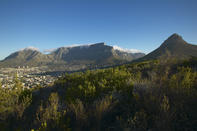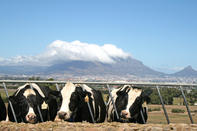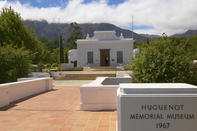European Settler and Explorers in the Cape
At first, the Dutch East India Company were utterly disinterested in the land beyond the Cape of Good Hope. Their only concern was to turn a profit by selling stuff to the passing fleets who called at Table Bay. Like any modern company, the bottom line was paramount, and the Dutch East India Company made no effort to invest in the country beyond its immediate operational needs.

Besides, the ‘Mountains of Africa’ seemed to cut off the Cape Peninsula from the wild interior of the country, and the Dutch East India Company was in no hurry to build expensive roads over the formidable peaks. The job of opening up the interior therefore fell on a motley crew of explorers, hunters, traders and cattle farmers, respectfully.
The first explorers were usually company employees who were ordered to venture out into the wild, unknown of the South African interior to gather intelligence about the local tribes. Men like Jan Dankaert, Pieter Potter, Heironymous Cruse, Pieter Van Meerhof, Ensign Buetler and Pieter Cruijthof were among the first to be sent out from the Fort, to probe the mountains to the East and the North. Later, the occasional governor, like the conscientious Simon van der Stel or the intrepid Joachim van Plettenberg, would also undertake a journey to the far-flung reaches of his realm, to check on the situation first hand.
Cattle Traders of East India Company

Following the hunter, came the cattle traders; first on behalf of the East India Company, then on behalf of themselves. These canny businessmen were always looking for a way to get ivory, gold, animal skins and fat cattle away from the local tribes-people.
Sometimes they used beads, sometimes they used persuasion, sometimes they just used force. Many of their ‘trading expeditions’ were no more than poorly disguised cattle raids, and this made many of the natives understandably resentful.
As explorers, hunters and traders (sometimes in the guise of the same person) spread out over the tenuous mountain passes into the interior, the game and the local tribes folk retreated before their thundering guns.
Before long, the once great herds of buck, buffalo and elephant were depleted, and many of the indigenous people (the Bushmen, in particular) found their livelihood under threat. Things were looking bad for the locals, and the encroaching Trekboers were about to make the situation a whole lot worse.
Early Scientists of the Cape
The next wave of explorers were botanists, ornithologists, scientists and adventurers; men of the Enlightenment who were eager to name new species and document natural wonders never before seen by Western eyes.
This group included learned people like Carl Thunberg and Anders Spaarman, who both sent samples of new species of life back to Carl Linnaeus (the Swedish botanist who developed the system of binomial nomenclature, which we still use to classify living things according to their genus and their species). These early scientific expeditions were often accompanied by surveyors and other Company employees, who constantly scanned the land to see if there was anything valuable.
The final wave of explorers were the upper-class travellers who ventured out into the wild open spaces of Africa so that they could fill their journals with piquant observations and stories. These exotic tales, they hoped, would turn their books into best-sellers back in Europe, and were among the first examples of modern travel writing. Some of these literary adventurers were Lady Anne Barnard, William Burchell and John Barrow.
Although, from a modern perspective, it is easy to dismiss these journeymen as condescending and culturally ignorant but they did much to document the environmental and cultural condition of an untouched Africa.
Hunters
In the footsteps of the explorers (and sometimes even ahead of them) came the hunters. They were a burly lot who hunted for the pot, for leather and for the hell of it. Much to the disgust of the indigenous people, the white hunter would often kill a noble beast, hack off a memento and leave the rest of the carcass to the vultures. To them it seemed that the hunters liked to shoot anything that moved, but didn’t like to move anything they shot.Original Capetonians

Perhaps it was prophetic that one of the names given to the Cape by the Portuguese sailors who passed it on their way to the east during the 15th, 16th and 17th centuries was Cabo Tormentoso, or Cape of Storms. In a few hundred years the social scene at the southern tip of Africa was to change from fairly simple, to one of the most complex and dynamic in history.
When Jan van Riebeeck, leader of the first Dutch settlers to the Cape, arrived there in 1652 the only inhabitants were Khoikhoi herders and 'strandlopers', or beachcombers.
Further inland, the colonists made scant contact with the elusive San nomads, who at that time wandered in small hunter-gatherer clans across most of Southern Africa. Van Riebeeck's party was sent to establish a halfway refreshment station between the Netherlands and Batavia (now known as Central Jakarta), the former country's trading headquarters in the east.
From tentative beginnings on the shores of what Sir Francis Drake is reputed to have called 'the fairest Cape in all the circumference of the world', grew the city of Cape Town.
 Cape Town, located in the Western Cape Province, is referred to by many as the Gateway to South Africa. No other city in the world can compa...
Cape Town, located in the Western Cape Province, is referred to by many as the Gateway to South Africa. No other city in the world can compa... Cape Town's City Centre has too many interesting features and sites to mention - it is best for visitors to walk from one place to the next,...
Cape Town's City Centre has too many interesting features and sites to mention - it is best for visitors to walk from one place to the next,...